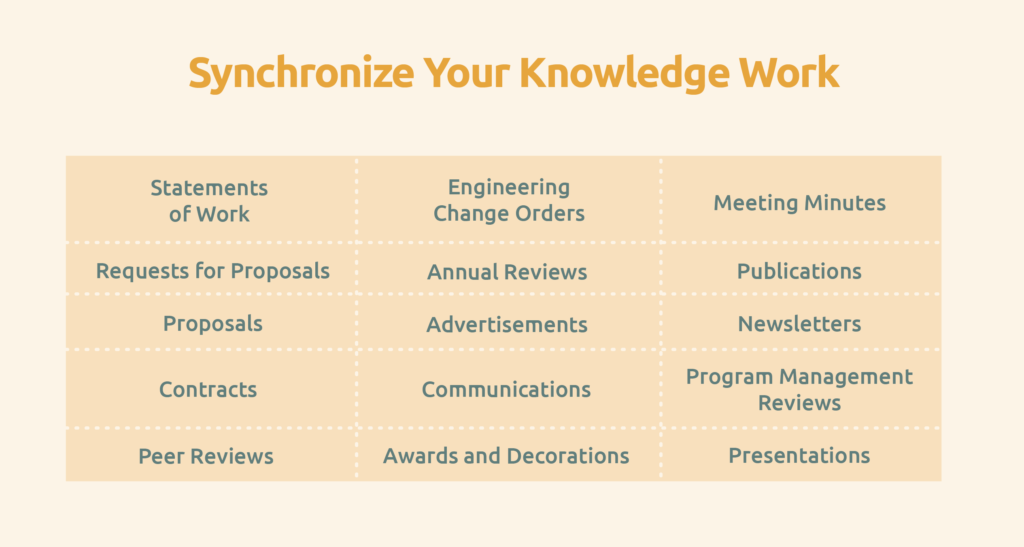
Want to learn how to shave weeks off knowledge work—with valuable learning as an added return on your investment?
The first order of business is determining how long it takes for your organization to create, review, and approve documents. That means any document, from sales orders to proposals to press releases. I measure the time for a document to be approved in four ways:
- Touch time—time actually spent working on the document (researching, thinking, writing, reviewing, correcting, re-reviewing).
- Lead time—starting the clock at initial research and ending with the final approved document.
- Quantity of handoffs—the number of people that must touch the document.
- Rolled Throughput Yield (RTY)—the percentage of time that each handoff is complete and accurate, multiplied together. When a handoff is not complete or accurate, it causes the preceding items in this list to increase.
I’ve seen as many as 54 approvals needed for a contract award from different people at different levels in different disciplines with a lead time of a year. And all those people have other tasks on their lists, so a queue forms in their email inboxes, especially when there’s a lack of organizational focus. When that contract task finally pops to the top of the list, what are the chances it’s 100 percent complete or that all the appropriate information has been provided? In many organizations, zero. That means rework.
In fact, you can take the percentage of time that requests are actually complete and accurate at each handoff and multiply them together to compute what’s known as rolled throughput yield (RTY). In my experience consulting on contracting and other processes, RTY of a knowledge process is often below 10 percent.
Why build unnecessary waste into your knowledge processes when there are proven ways to eliminate it?
I’ve seen an engineering process take 28 handoffs with an RTY of 2.02%, a touch time of 90 hours, and a lead time of 239 days. And I worked once on a contract proposal that had to be routed through 44 people—all of whom could reject it for various reasons, but none of whom had clear criteria for approval. You can imagine what that was like.
The thing is, we’ve come to expect rework—so we build time for it into our processes, which actually becomes a self-fulfilling prophecy. (That’s Parkinson’s Law.) Why do we do that, when it isn’t necessary?

Cutting to the Heart of Knowledge Waste
The main source of waste in knowledge processes is asynchronous working. That is, many intelligent, competent people are working hard—but not together. We’ve withdrawn to cubes and offices, and we even work remotely, sometimes in different time zones. Here’s what that looks like:
- Individuals optimize their knowledge contributions when it suits them best—but not when it suits the process. That creates waiting, or lead time.
- There is little standardization of what is expected from each participant, and the criteria for approval are capricious or fickle.
- Without an understanding of what the criteria are at each handoff (by the originator of the document and the reviewer), the document is not 100% complete and accurate when it moves on. So it goes back and forth, usually accompanied by a time-consuming round of email ping pong. More touch time and lead time.
- Worst of all, because no one is working together, there is no learning. This comes at a very high cost for knowledge workers and the process.
The solution can be found in lean thinking, which identifies and eliminates wastes from the value-added tasks we do each day. The value-added part of knowledge work is the collaboration of input from knowledge workers, and the wastes are the waiting, transportation, rework, multiple inspections, work in process, and lack of organizational focus.
The ultimate lean countermeasure to waste is called a “cell,” which is a familiar concept to those of you in manufacturing. It means locating everything you need at the point of use (close at hand), in the right quantity (not too much or little), and at the right time (not too early or late) in order to meet customer demand. It’s the point where time, space, and info are optimized for throughput.
Creating a Cell for Knowledge Work
How do you apply the concept of cells to the business office?
Articulate your organizational focus and decide what’s important—and then limit work in process (WIP) using that filter. Knowledge workers are often slaves to email and meetings, but in reality, there’s other more important work to be done. And switch-tasking all day is very wasteful and draining. Creating your strategy and managing it with a WIP board allows you to prioritize the most valuable documents and finish them in a timely fashion.
A WIP board is just one example of a lean tool that can help you create cells for knowledge work. Another I often recommend is called single-text negotiation, or STN, which is outlined in the book Getting to Yes: Negotiating Agreement Without Giving In by Roger Fisher and William Ury. It’s really valuable for important documents that need multiple handoffs. The suggested steps:
- The originator should create the draft and place the draft number in the document name.
- Distribute the document to stakeholders. Provide a few days of review and schedule a meeting.
- At the meeting, project the document on a screen (or do it virtually via meeting software). Then facilitate the review of the document synchronously with all stakeholders. When there is a requested edit or change, all stakeholders witness it in real time. They can consider how the change affects each of their contributions, ask why the change is needed, and discuss how the document may need to evolve to accommodate the change. Done!
This exchange may take time, but far less than if done asynchronously. And the benefit is real-time learning, a great return of investment. The originator is aware of the needs of the stakeholders, making future edits less likely. And variation is reduced (a huge bonus—I could go on all day about that, but instead just read my previous post.)
There are many ways to use STN to improve productivity. Ever walk out of a meeting and not really know what was decided? Or find all the attendees interpreted what was said differently? Use STN on your meeting minutes to gain a documented consensus of what was discussed.
STN can also be used to create standard work—the documentation, communication, and storage of best practices. An employee can create a draft checklist as the best way to execute a task. That employee presents it to co-workers, who then provide their input to create a consensus of the best practice. This becomes the standard to conform to and to be rated on, which is a big win for employees and supervisors alike.
STN Gets Results
Using STN for reconciling statements of work, reviewing meeting minutes, etc., can cut lead times dramatically, in some cases by months. One of my program manager (PM) clients recently told me that STN had knocked weeks off her contracting process.
Her documents must normally be routed among a team of engineers, finance people, logisticians, and contracting officers, and then up the chain of command and through a few review teams. Before she started using STN, the document was usually beaten up pretty badly in review and then sent back down to the team for more rounds of edits.
But not anymore. With real-time discussions taking place among all stakeholders, the PM now understands the whole of the document better than anyone. She learns and can better defend critiques of the management and review teams, increasing her knowledge, confidence, and circle of influence.
Getting people to agree to come together for the sake of the process rather than the benefit of the individuals is sometimes difficult, but not as difficult as 54 handoffs or 239 days of lead time. Count your handoffs and calculate your lead time and use those to create what we in lean call “hatred of the current state.”
Start by asking those within your influence and give the process a try. The first STN will be a little difficult, but that’s to be expected because no one yet has working knowledge of the whole process. Once, when I was facilitating a standard sales proposal with a sales team using STN, they spent almost the entire first hour on the font! But then the process began to flow, the proposal was dramatically improved, and future STNs went much faster.
Why build unnecessary waste into your knowledge processes when there are proven ways to eliminate it? It’s so much smarter to synchronize. You’ll be amazed at the time it frees up for more productive thinking.
